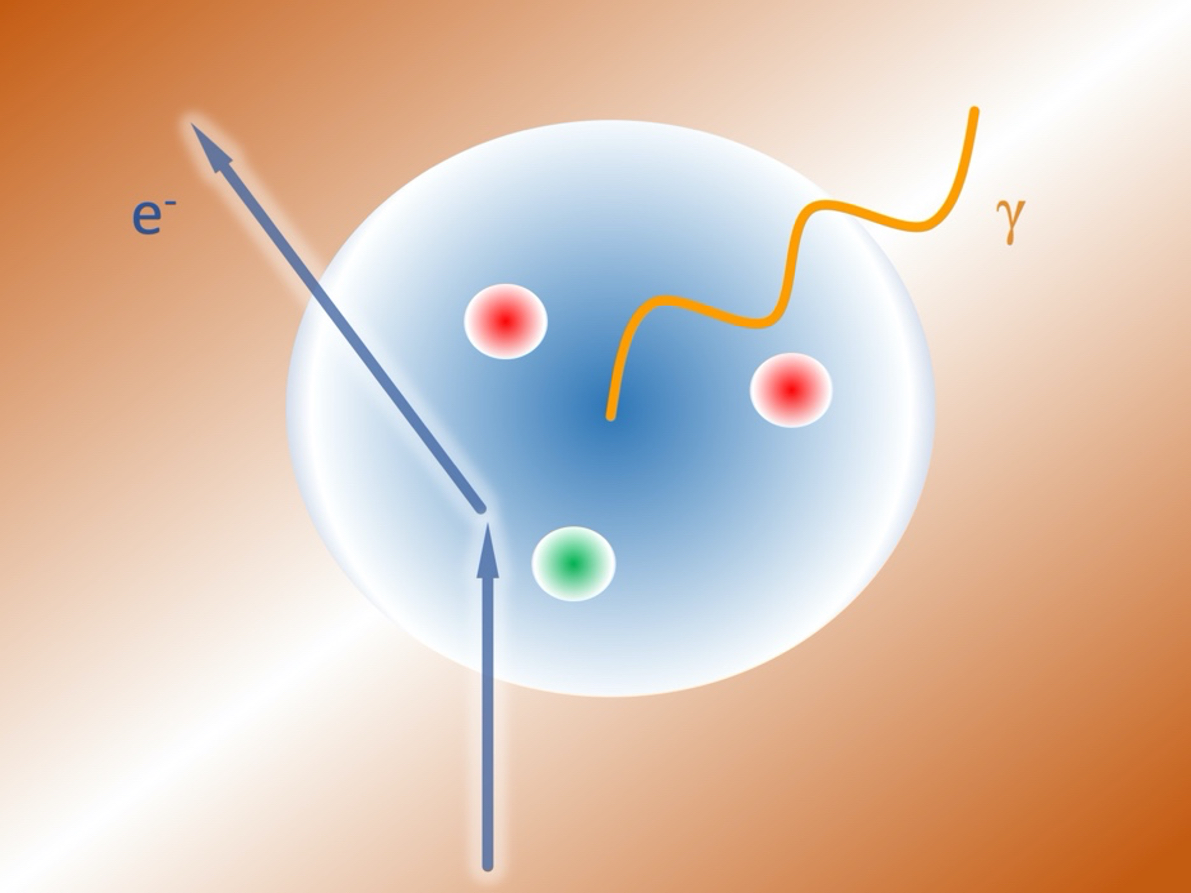The real photon that is produced in the virtual Compton scattering reaction provides the electromagnetic perturbation to the proton and allows to measure its electromagnetic generalized polarizabilities. Image courtesy of Nikos Sparveris, Temple University
A precision measurement of how a proton’s structure deforms in an electric field has revealed new details about an unexplained spike in proton data
NEWPORT NEWS, VA – Nuclear physicists have confirmed that the current description of proton structure isn’t all smooth sailing. A new precision measurement of the proton’s electric polarizability performed at the U.S. Department of Energy’s Thomas Jefferson National Accelerator Facility has revealed a bump in the data in probes of the proton’s structure. Though widely thought to be a fluke when seen in earlier measurements, this new, more precise measurement has confirmed the presence of the anomaly and raises questions about its origin. The research has just been published in the journal Nature.
According to Ruonan Li, first author on the new paper and a graduate student at Temple University, measurements of the proton’s electric polarizability reveal how susceptible the proton is to deformation, or stretching, in an electric field. Like size or charge, the electric polarizability is a fundamental property of proton structure.
What’s more, a precision determination of the proton’s electric polarizability can help bridge the different descriptions of the proton. Depending on how it is probed, a proton may appear as an opaque single particle or as a composite particle made of three quarks held together by the strong force.
“We want to understand the substructure of the proton. And we can imagine it like a model with the three balanced quarks in the middle,” Li explained. “Now, put the proton in the electric field. The quarks have positive or negative charges. They will move in opposite directions. So, the electric polarizability reflects how easily the proton will be distorted by the electric field.”
To probe this distortion, nuclear physicists used a process called virtual Compton scattering. It starts with a carefully controlled beam of energetic electrons from Jefferson Lab’s Continuous Electron Beam Accelerator Facility, a DOE Office of Science user facility. The electrons are sent crashing into protons.
In virtual Compton scattering, electrons interact with other particles by emitting an energetic photon, or particle of light. The energy of the electron determines the energy of the photon it emits, which also determines how the photon interacts with other particles.
Lower energy photons may bounce off the surface of the proton, while more energetic photons will blast inside the proton to interact with one of its quarks. Theory predicts that when these photon-quark interactions are plotted at from lower to higher energies, they will form a smooth curve.
Nikos Sparveris, an associate professor of physics at Temple University and spokesperson for the experiment, said this simple picture didn’t hold up to scrutiny. The measurements instead revealed an as-yet-unexplained bump.
“What we see is that there is some local enhancement to the magnitude of the polarizability. The polarizability decreases as the energy increases as expected. And, at some point, it appears to be coming temporarily up again before it will go down,” he said. “Based on our current theoretical understanding, it should follow a very simple behavior. We see something that deviates from this simple behavior. And this is the fact that is puzzling us at the moment.”
The theory predicts that the more energetic electrons are more directly probing the strong force as it binds the quarks together to make the proton. This weird spike in the stiffness that nuclear physicists have now confirmed in the proton’s quarks signals that an unknown facet of the strong force may be at work.
“There is something that we're clearly missing at this point. The proton is the only composite building block in nature that is stable. So, if we are missing something fundamental there, it has implications or consequences for all of physics,” Sparveris confirmed.
The physicists said that the next step is to further tease out the details of this anomaly and conduct precision probes to check for other points of deviation and to provide more information about the anomaly’s source.
“We want to measure more points at various energies to present a clearer picture and to see if there is any further structure there,” Li said.
Sparveris agreed.
“We also need to measure precisely the shape of this enhancement. The shape is important to further elucidating the theory,” he said.
Further Reading
Measured proton electromagnetic structure deviates from theoretical predictions
Experiment Proposal: E12-15-001 – Measurement of the Generalized Polarizabilities of the Proton in Virtual Compton Scattering
Contact: Kandice Carter, Jefferson Lab Communications Office, kcarter@jlab.org


